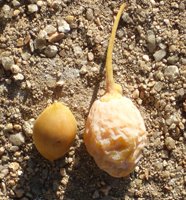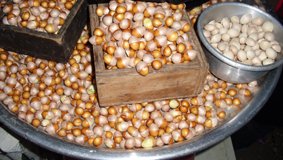Selection and storage
 |
| Ginkgo biloba fruit and seed. |
Fresh ginkgo nuts appear in the markets by October and stay so until the end of February. Actually, fresh ginkgo fruits that fall off the trees are hand-picked and processed further to obtain edible nuts. Each ginkgo fruit consists of an outer fleshy inedible pulp, like as in date fruit, known as sarcotesta.
In the rest of the world, however, ginkgo nuts are rarely heard about and oftentimes recommended for medicinal purposes to improve stamina and respiratory functions. In the United States, the FDA has not approved the use of ginkgo nuts as a food item or food additive.
In the groceries, choose fresh whole dry nuts that are heavy for their size, and have clean smooth surfaces. Raw, shelled kernels in air-tight packets and canned ginkgo can be readily available in stores specializing in the sale of Far-East Asian food items.
Fresh, unshelled nuts can be stored at room temperature for few a weeks; and inside the freezer section of the home refrigerator for several months. Shelled kernels, however, should be used sooner since they tend to turn rancid. Shelled nuts, however, stay in good condition for a couple of days stored in the refrigerator.
Culinary uses

|
| Raw fresh ginkgo nuts in a South Korean market. |
Fresh Ginkgo nuts are a delicacy in China, Japan, and the Korean peninsula. Natives of the East-Asia region generally eat them
toasted and dried or boiled in dishes. The process of cutting open their tough outer shell can be made easier if you toast the whole nut for a few minutes in a frying pan. Then, using hand pliers or a small hammer, gently hit the nut to crack it open. Gently peel thin, outer brown
membrane enveloping around a single, jade-green edible ginkgo kernel inside.
Here are some serving methods:
-
Ginkgo nuts are a special delicacy in East Asian cuisine. In Japan (ginnan or white nuts), which they welcomed as autumn and New Year seasonal wonder, are a unique addition to savory egg custard known as chawanmushi.
-
In the Korean Peninsula, the seeds are served during marriage and traditional ceremonies.
-
In China, ginkgo nuts (Bai Guo) are one of the seasonal ingredients found used in soups (soybean-curd soup), porridge, as well
as in stir-fries.
Safety profile
Ginkgo nuts poisoning, although rare, is not uncommon. Eating more than ten raw or cooked nuts in a day may cause 4’-O-methylpyridoxine (Ginkgotoxin) poisoning. Ginkgotoxin interferes with pyridoxine (vitamin B-6) metabolism, and the symptoms may include stomachache, nausea, vomiting, nervous irritability, convulsions, and sometimes death. The toxicity and symptoms, however, can be reversed by taking pyridoxine supplements.
Again, one should be very careful while handling its soft, mushy flesh around the nut with bare hands. Certain toxins such as urushiol in the fruit, and the pulp may cause severe dermatitis (similar to poison ivy) in some sensitive persons. (Medical Disclaimer).
≻≻-Back to Nuts and Seeds from Ginkgo nuts. Visit here for an impressive list of nuts with complete
illustrations of their nutrition facts and health benefits.
≻≻-Back to Home page.
Further Resources:
-
Maidenhair tree-pdf.
-
Ginkgo biloba by Teris A. van Beek- Laboratory of Organic Chemistry Wageningen Agricultural University, The Netherlands- PDF.

